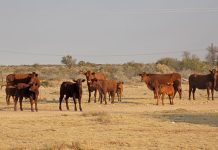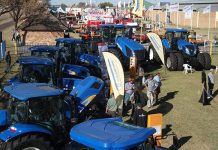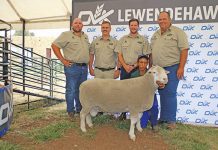Wouter Kriel
Best known for his work on crop rotation, Dr Mark Hardy from the Western Cape’s Department of Agriculture was recently voted scientist of the year by Grain SA. With years of experience, Hardy notes with concern that research into soil health, especially in the winter rainfall regions, is still in its infancy. Listing herbicide resistance and insect infestations as immediate challenges, Hardy would like to see more research into general soil health, and particularly the effects monocultures have on soil organisms. Wouter Kriel recently spoke to him, and discovered a man with a high regard for the skill of local farmers.
How does the Grain SA award for Scientist of the Year sit with you?
First, I must say the work we do is a team effort and it would be remiss of me not to acknowledge the input of my many colleagues and the farmers we work with. This award is also an acknowledgment of their efforts. Second, scientists and researchers normally do their jobs out of love or a passion for their subject matter. We want to make a difference, but don’t expect great recognition for it.
The award came as a pleasant surprise and I’m grateful for the acknowledgment from producers for our efforts in trying to assist them in their production systems. It’s difficult to judge the influence one’s work has out there in the commercial field, but since this award comes from the industry, and not my scientific peers, I see it as an indication our work has been of value to producers. The award motivates me to continue my research, and enhance the mutual respect existing between commercial producers and the scientific community in South African agriculture.
You are best-known for your work on crop rotation. What other research are you involved in?
I’m a trained pasture scientist and support colleagues on several projects that involve veld or pasture research. I recently worked with Dr John Labuschagne on strategies for applying nitrogen to pastures, and another project with Nelmarie Saayman is looking at ways to manage invasive Gombos (Pteronia paniculata) in the succulent Karoo. Within my crop rotation work, I’m interested in the processes and interactions between the soil and plants, and how the understanding of these processes can promote a sustainable cropping system.
What is being done regarding soil health research for dryland agriculture in South Africa?
Soil health research, especially in the winter rainfall areas, is still in its infancy and very little is currently being done in this field. Positive observations on water retention and soil microbial activity have been made in no-till systems. Some producers are already using products that claim to promote soil biological activity. There are positive, but unquantified results and there are cases were no differences could be observed.
It seems this is the direction producers are moving towards, but very little technical knowledge regarding soil health exists at the moment. The scientific community is talking about collaborative studies to address gaps in our pool of knowledge. The different effects of monoculture and crop-rotation regimes on soil microbial activity and the effect of tillage methods on soil organisms are examples of work currently being done. This work is expensive, due to its time-consuming nature and the equipment required.
Are South African dryland farmers better than their Australian counterparts?
You can’t really compare the two, as the environments differ drastically. For example, Australia cultivates more than 23 million hectares of cereal, protein and oilseed crops on huge, flat farms, whereas only about 450 000ha are planted to the same crops in the Western Cape on relatively small, hilly farms. Due to the economies of scale, the Australian industry has lower capital investment per hectare of cultivated land. They also have better and more focused research facilities and support structures available for their producers, and it would be unfair to compare the South African industry to theirs.
How would you describe current dryland agriculture in South Africa?
South Africa has a very limited amount of arable land, of which a small percentage has high production potential. We have limited rainfall and our soil tends to be shallow. Conditions are by no means ideal for production, yet we do it. To me that means a successful farmer in South Africa is an exceedingly good farmer. South Africa’s grain production is small compared to the world market, making us price takers, and we’re exposed to currency fluctuations and expensive inputs. So it’s not only the natural environment that’s harsh, but also the financial one.
What kind of person does it take to succeed as an emerging farmer under such adverse conditions?
Emerging farmers need to be very special people if they are to succeed as rain-fed commercial producers. They need business acumen, technical knowledge, and a sound understanding of the value chain. But above all, they need to be passionate about agriculture, and the accompanying lifestyle, as there are other investments offering better returns than rain-fed agriculture.
What do you see as the major challenges facing dryland agriculture in South Africa? There are immediate and long-term challenges. Herbicide resistance, plant disease and insect infestations are immediate challenges, but I think we have the tools at hand to address these problems. Long-term challenges would be to protect our soil and water resources. We need to face up to climate change which will necessitate soils to retain moisture better and for longer periods. Soil carbon levels are crucial and need to be built up. The retention of crop residue is important, and the residue also shades the soil, slowing down evaporation. Soil management will need to address the carbon to nitrogen ratio and improve the soil nutrient balance. This will improve the availability of nutrients to crops.
Do you see a future for dryland crop cultivation in South Africa?
In South Africa we have 16,5 million hectares of arable land, of which 90% is of mid to low potential. Most of this land is or has been cultivated, and there is maybe another 2 million hectares of uncultivated land left with potential. The problem is that this low or medium potential land has not been able to produce crops profitably during the past 20 years.
This has led, for example, to a decline in the area planted to wheat in the Western Cape from 800 000ha in the 1980s to the current 350 000ha. Low profitability has resulted in land being abandoned and there is little room for commercial expansion. We need to use our available land more productively and increase the yield per hectare by using the appropriate management systems, and at the same time, protecting our soil and water resources. A current long-term study has shown a wheat-on-medics rotation will improve wheat yield by 35% when compared to wheat following wheat in monoculture, so there are ways and means to face the challenges. Contact Dr Mark Hardy on (023) 614 3839 or e-mail [email protected]. |fw








